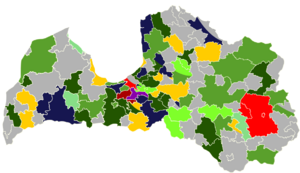2017 Latvian local elections facts for kids
Local elections in Latvia happened on June 3, 2017. These elections chose people to work in the councils of all 119 towns and cities across the country. These local councils help manage things like schools, roads, and public services in their areas.
Contents
How Elections Work
In Latvia, the number of people who work in a local council depends on how many people live in that area. If a town or city has more people, its council will have more members. Councils can have 9, 13, 15, 17, or 19 members. However, the capital city, Riga, is much bigger than any other city. So, its council has 60 members!
To vote in these local elections, you need to be at least 18 years old. This applies to citizens of Latvia and also to citizens from other countries in the European Union (EU) who live in Latvia. If you're an EU citizen, you just need to be registered in Latvia's Population Register at least 90 days before the election.
People vote in the area where they live or where they own property. Usually, you're automatically registered to vote at a specific polling station near your home. But if you want to, you can change your polling station up to 18 days before the election.
On election day, polling stations are open from 7 AM to 10 PM. You can also vote early! Polling stations open for a few hours during the three days before the main election day.
The Election Campaign
Many people wanted to become council members! Across Latvia, 599 different lists of candidates were registered. In total, 8,945 people hoped to become deputies.
Most of these candidate lists (465 of them) were put forward by single political parties. Some lists (31) were from groups of parties working together, called coalitions. And 103 lists were from groups of voters who came together.
Most of the candidates (about 77%) were ethnic Latvians. About 4% were ethnic Russians, and a small number were ethnic Poles or other groups. About 17% of candidates chose not to share their ethnic background.
Many people voted early. About 167,000 people, which is 11.6% of all voters, cast their votes between May 31 and June 2. Overall, about 50.41% of all eligible voters took part in the local elections. That's 727,839 people!
Election Results
The map below shows the results of the local elections across Latvia. Each color on the map tells you which political party won the most votes in that area.

Union of Greens and Farmers Latvian Farmers' Union Latvian Green Party Latvian Association of Regions National Alliance Unity Harmony Latvian Social Democratic Workers' Party New conservative party Regional parties
Let's look at the results from Latvia's two biggest cities: Riga and Daugavpils.
Riga's Election
Before these elections, Riga was led by a group of parties called "Harmony" and "Proud to serve Riga." Nils Ušakovs, from the "Harmony" party, was the mayor and head of the city council. Other parties in Riga wanted to work together to choose a new mayor.
After the elections, the "Harmony" and "Proud to serve Riga" group still won the most seats. They got 32 out of 60 seats in the council, which is a majority. Even though they lost a few seats, Nils Ušakovs was re-elected as the head of the city council on June 22, 2017.
| Party | Votes | % | Deputies | Change | |||
|---|---|---|---|---|---|---|---|
| Harmony — Proud to serve Riga | 127099 | 50,82 | 32 | ||||
| LAR — Latvian Development | 34176 | 13,66 | 9 | ||||
| New Conservative Party | 33553 | 13,42 | 9 | ||||
| National Alliance | 23135 | 9,25 | 6 | ||||
| Unity | 15653 | 6,26 | 4 | ||||
| Others | 15514 | 6,21 | 0 | ||||
| Overall (turnout 58,72 %) | 249130 | 99,61 | 60 | — | |||
| Source: Central Election Commission of Latvia | |||||||
Daugavpils' Election
In Daugavpils, the mayor before the elections was Jānis Lāčplēsis from the Latgalian party. He had been chosen by everyone on the council in 2013.
After the 2017 elections, the Latgalian party won more seats in the council. However, they didn't get enough seats to have a majority on their own. Instead, two other parties, "Harmony" and "Our party," decided to work together. They formed a coalition.
On June 26, 2017, Andrejs Elksniņš from the "Harmony" party became the new mayor and head of the city council. Rihards Eigims, the leader of "Our party," became the vice-mayor.
This meant that the "Harmony" party became a leading force in the local councils of both Riga and Daugavpils, Latvia's two largest cities.
| Party | Votes | % | Deputies | Change | |||
|---|---|---|---|---|---|---|---|
| Latgalian party | 7899 | 28,57 | 6 | ||||
| Harmony | 7786 | 28,16 | 5 | ||||
| Our party | 5347 | 19,34 | 4 | ||||
| Other | 6316 | 22,85 | 0 | ||||
| Overall (turnout 47,33 %) | 27348 | 98,91 | 15 | — | |||
| Source: Central Election Commission of Latvia | |||||||

